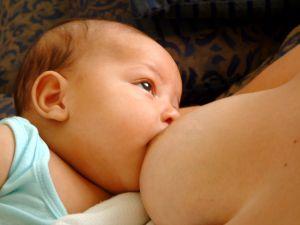No matter if it is straight from the breast or fed to the baby through a bottle, breast milk has been found to be the best way to nourish a baby in most cases. Breastfeeding provides the perfect nutrition as the baby grows because the mother’s milk changes as time goes by, matching the needs of the infant, according to the U.S. Department of Health and Human Services. Not only is it the best form of nutrition, it also provides protection, bonding and it is economical.
Process
During the first few hours of life, a new baby can be introduced to breastfeeding by gently rubbing the mother’s nipple on the baby’s lips. This will produce an instinctive urge to latch on and the baby will open her mouth to feed. Once the baby has the nipple and part of the areola in her mouth, the mother can pull the baby close. The baby then will close her mouth and start to suck.
Baby Benefits
According to the U.S. Department of Health and Human Services breast milk contains antibodies which protect babies from illnesses and SIDS (Sudden Infant Death Syndrome). Drinking breast milk can lower a baby’s risk of asthma, ear infections, respiratory infections, stomach problems, childhood leukemia and type 1 and 2 diabetes.
Mother Benefits
The U.S. Department of Health and Human Services says there are also benefits for the mom. Breastfeeding can lower the mother’s chances of developing breast cancer, type 2 diabetes, postpartum depression and ovarian cancer.
Plus, breastfeeding provides skin-to-skin contact for the mother and child. This provides a bonding time that can be beneficial for both the baby and the mother.
Economics
The U.S. Department of Health and Human Services estimates that a mother can save up to $3,915 a year by breastfeeding instead of using formula.
Time Frame
According to the U.S. Surgeon General, a new baby’s sole form of nourishment should be breast milk. A baby’s digestive system is not capable of processing solid or semi-solid foods before six months of age. After six months of age baby cereals and pureed vegetables and fruits can be added to the diet. The U.S. Surgeon General also recommends that breast milk be a part of a baby’s diet at least until it is one-year-old.
Caution
The U.S. National Library of Medicine suggests that mothers who have contagious diseases such as active tuberculosis or HIV avoid breastfeeding. They also state that drugs, medicines and alcohol consumed by the mother can contaminate breast milk that will be ingested by the baby. If you have any concerns about these subjects, talk to your doctor before giving birth to make an informed decision about breastfeeding.





